Future Design Basecamp to bring Njururi back to the Thika river
20 July 2023The Thika River in Kenya is struggling with immense industrial and agricultural pollution and erosion. In the past decades, the water quality has deteriorated at such a rate that the water beetle ('njururi'), that used to live in the river in great numbers, has disappeared entirely. To find a solution for this crisis, a three days Future Design Basecamp was organised to discuss the Thika river, which involved a wide range of stakeholders within the Thika River basin to work together to ‘bring Njururi back to the river’.
Bring Njururi back to the river
The Thika River in Kenya is intensively used by farmers, industry and drinking water companies. The river has its source in the Aberdare Forest, where the river is clean. Unfortunately, the story is not the same downstream with erosion and pollution leading to an unhealthy ecosystem, also threatening the supply of water to Nairobi city and other towns.
With support of the NWB fonds, Dutch organisation Embassy of the Earth and Dutch Water Authorities, represented by World Waternet, facilitated a three days future design process to discuss the Thika river, at the end of April 2023. Stakeholders and problem holders within the Thika River basin worked together to ‘bring Njururi back to the river’. This initiative took a different approach from what World Waternet does in the WaterWorX and Blue Deal programmes with Nairobi City Water and Sewerage Company and Water Resources Authority respectively. The reason for this is that managing a healthy river with so many beneficiaries is (too) complex to just leave it to one competent authority. And that a sustainable future can only be designed (and implemented) with all problem holders at the table in an unprecedented collaboration.
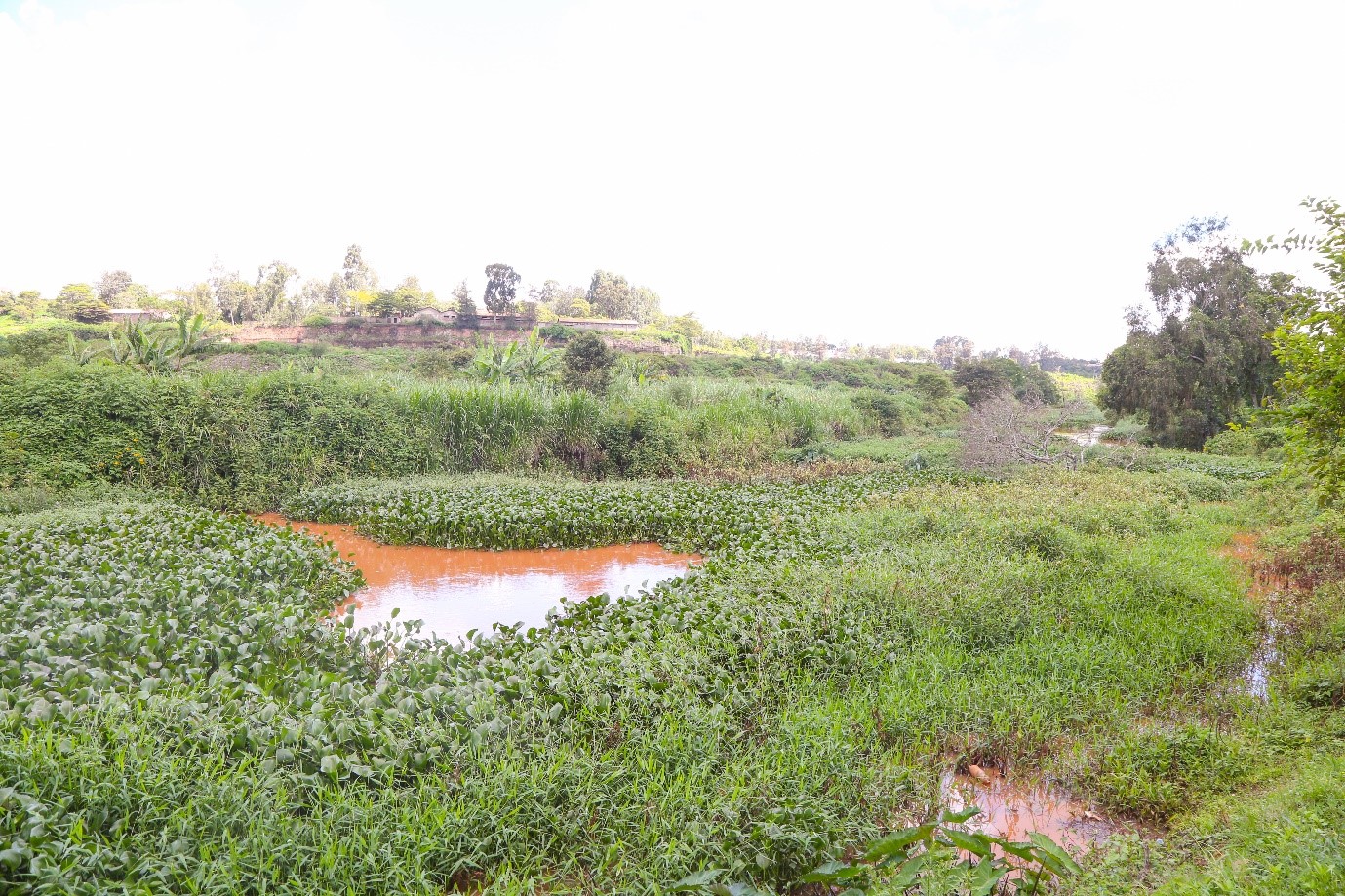 Thika river downstream, full with hyacinth, at Del Monte farm
Thika river downstream, full with hyacinth, at Del Monte farm
Community of stakeholders
In November 2022, a planning taskforce was formed from different problem holders, e.g., coffee, tea and pineapple companies, the Water Resources Authority, drinking water companies, Water Resources Users Associations (WRUAs), and the Ministry of Health. Frank Heckman of the Embassy of the Earth, together with World Waternet, facilitated the process. During the first meetings, Frank explained that the purpose of the initiative is to set up a community of stakeholders and problem holders to solve challenges on landscape and livelihood levels. Frank: “With common ground, possible futures, clear strategies, attainable objectives and far enough horizons, communities and regions are radically transforming their current collective realities of threat, stagnation and destruction.”
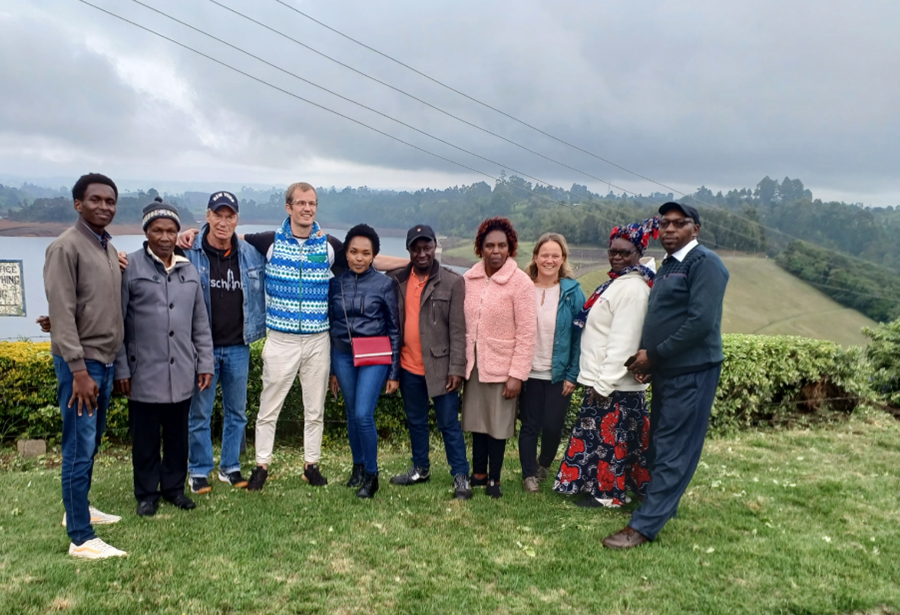 The Planning group
The Planning group
Right from the start, the planning taskforce was very enthusiastic. They talked about what the Thika river looked like in the past and came up with the slogan: ‘bring Njururi back to the river’. Njururi is a local name for a water beetle, that lives in clear and clean water, and therefore it is a symbol to improve the ecosystem of the Thika river. The Njururi also has a deep traditional connection related to womanhood in the Kikuyu community leading to hilarity time and time again.
Future Design Basecamp
The task of the planning taskforce was to organise a Search Conference, later renamed to Future Design Basecamp (FDB). This involved defining the system boundaries, selecting FDB participants and brief them, informing and involving key-stakeholders, looking after logistics, doing communication and preparing the opening ceremony of the FDB. It was not like preparing any type of conference! Every step in the preparation process for a Future Design Basecamp is thoroughly thought through and critical for success on the back-end. The planning taskforce learnt a lot about the application of socio-ecological thinking during their meetings and six preparatory stakeholder dialogues.
The Future Design Basecamp was hosted at the clubhouse grounds of Del Monte and kicked off with the opening ceremony. About 120 people representing industry, farmers, water companies, counties, other government agencies, and forestry were present. CEOs and other representatives of Del Monte, Water Resources Authority, Nairobi City Water and Sewerage Company, Athi Water Works Development Agency, County Government, and WRUAs indicated the importance of the subject. The official part was followed by a lot of music and dancing and a walk to the river where we had a moment of silence, prayers, dancing and singing to honor the river.
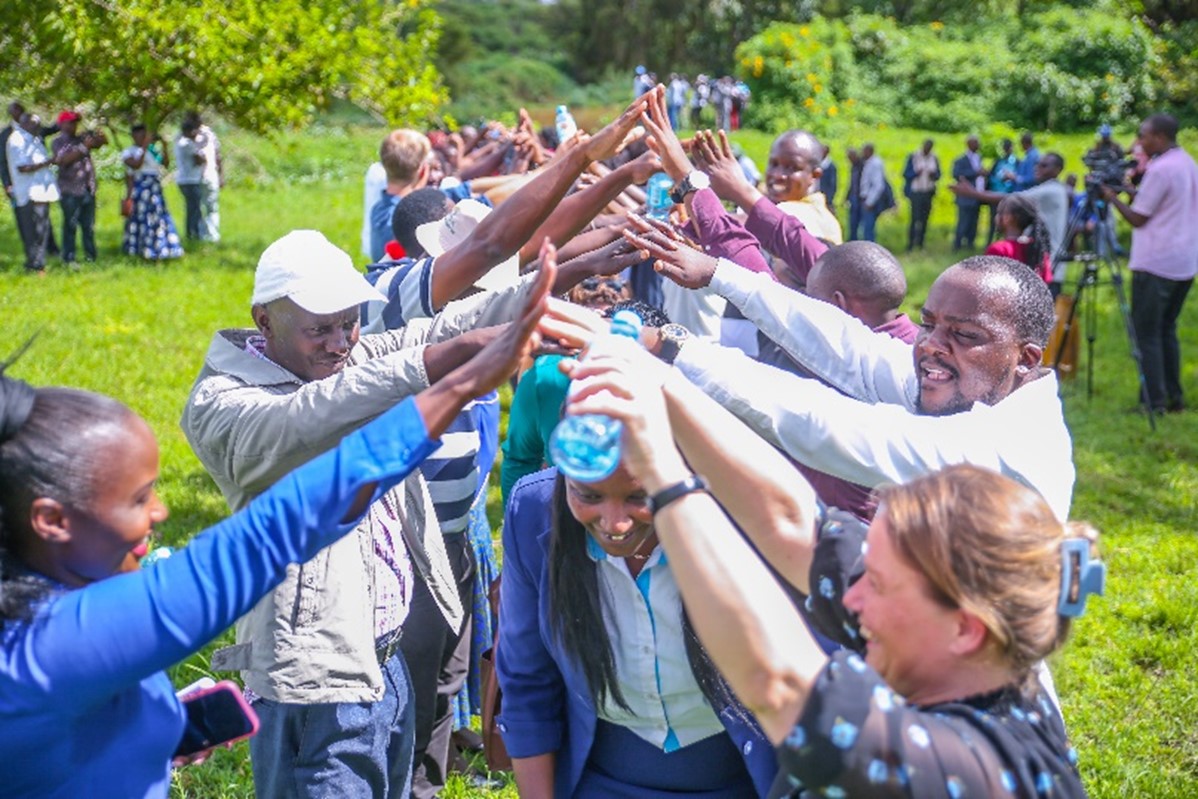 Dancing a Njururi song at the river
Dancing a Njururi song at the river
At the end of the day, about 60 people stayed in the basecamp for the next three days. It was a real basecamp, where everybody slept in tents (some people for the first time in their lives) and sat around the camp fire in the evening. The next morning, the three days lasting Future Design Basecamp now really started.
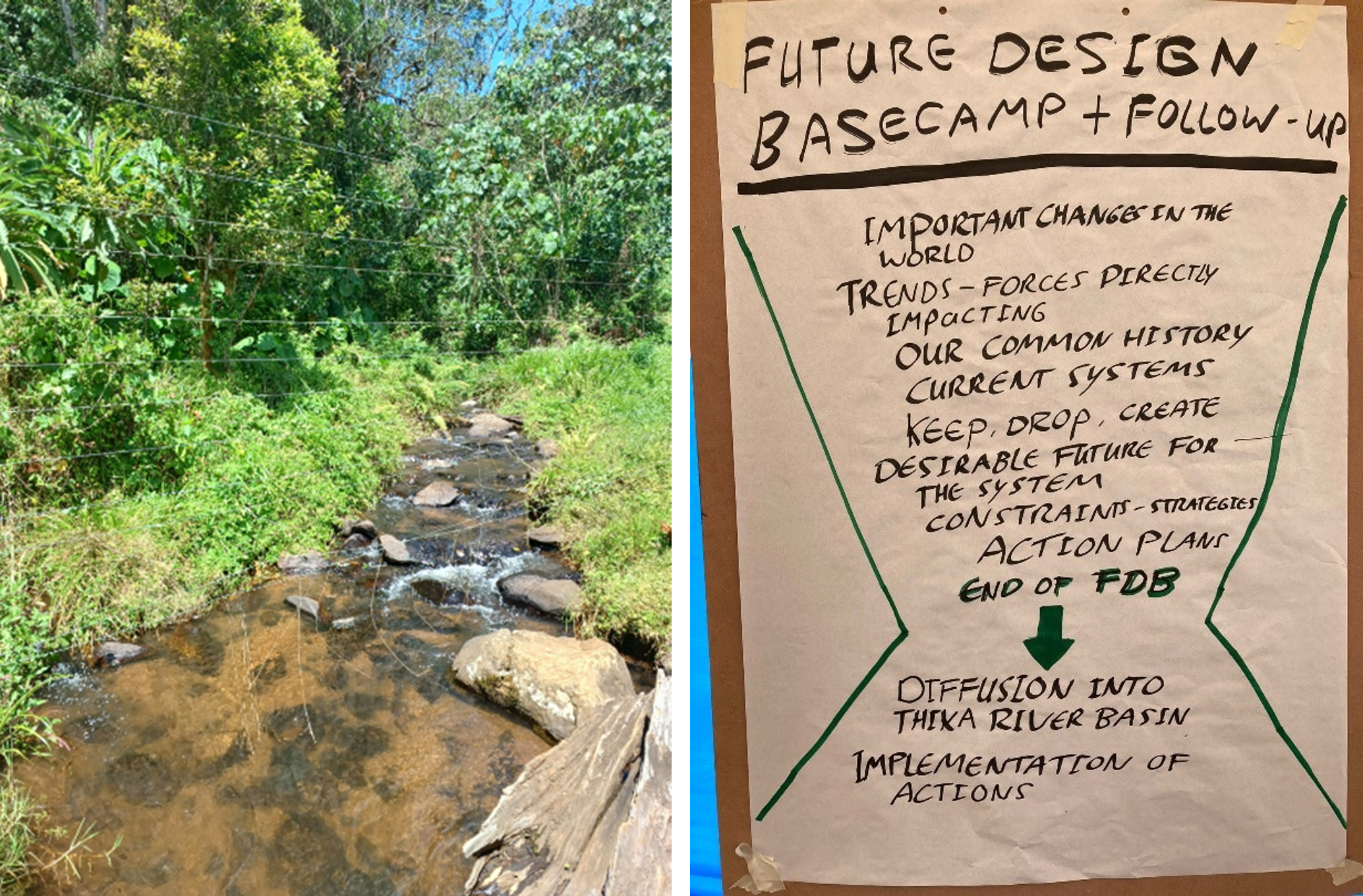 Thika River at the source Gatare forest (left) and the FDB process (right)
Thika River at the source Gatare forest (left) and the FDB process (right)
In a deliberate process, participants worked together and discussed about: important changes in the world, trends – forces directly impacting (impact scan), our common history, current systems, what do we want to keep/ drop/ create, desirable future for the system and constraints and strategies. This resulted in a vision statement created by the problem holders.
Vision statement 2033Beautiful rivers with clean, clear and sufficient water in a reclaimed, restored and protected wetland and river ecosystem, through proper policy and regulations, good agricultural and industrial practices. Bringing back Njururi, abundant aquatic life and vegetation of native species throughout the Thika River Basin. The river ecosystem provides the communities with all their needs. In return the communities are the custodians of the Thika River Basin. |
Bring Vision into Action
The third day of the FDB was dedicated to developing actions plans with maps for five themes the participants had identified: water quality and quantity, conservation, policy/legal, biodiversity and recreation. Community involvement and climate change are central within all themes. The five taskforces have ownership over implementation of their action plans while an elected coordinating council is responsible for coordination.
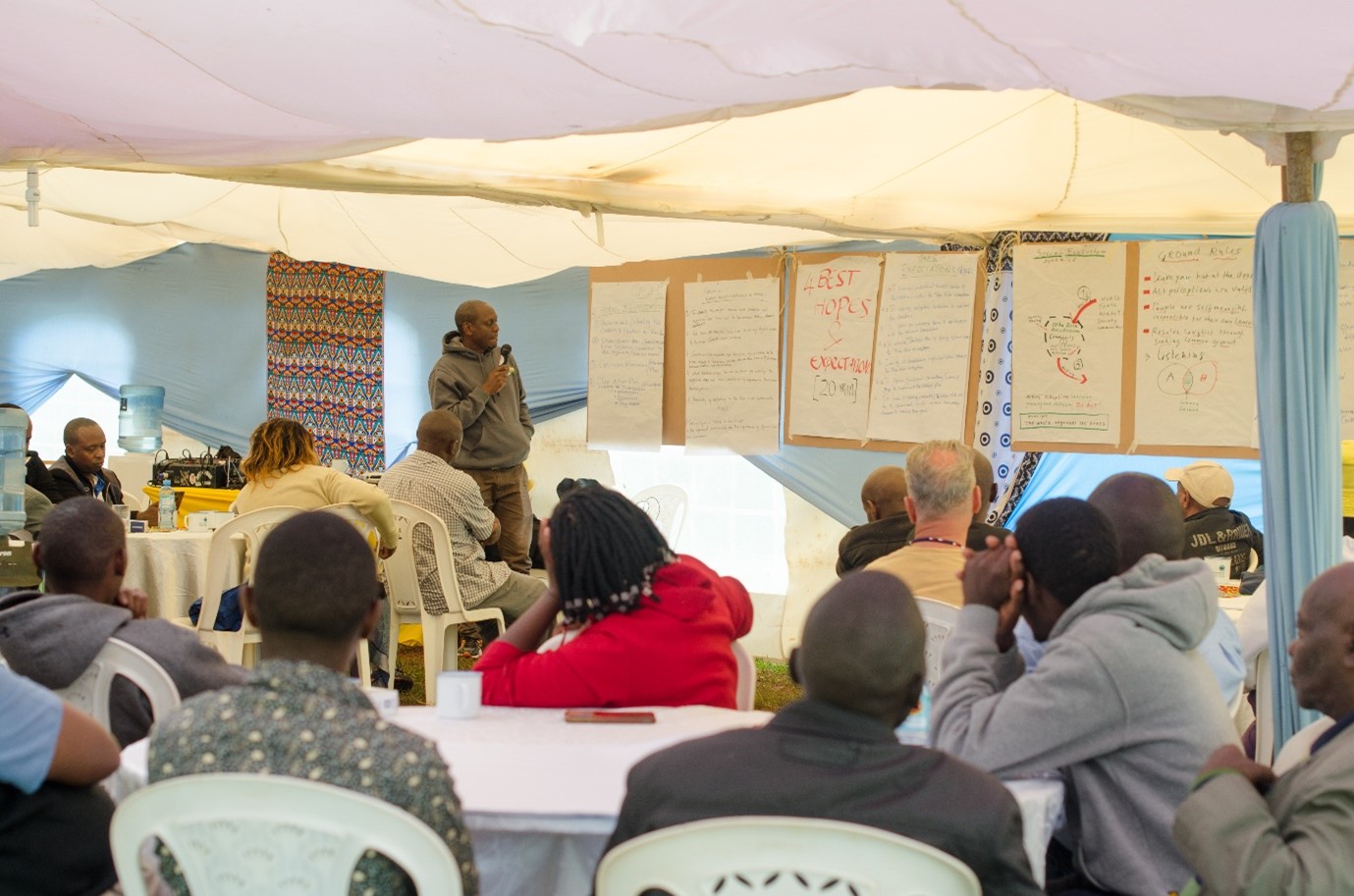 Group work during the FDB
Group work during the FDB
The Future Design Basecamp was a unique way to work together with all the important stakeholders of the Thika river basin. It is a great example of a bottom-up process. Especially after the history session, people got really motivated to make the river clear and clean again, like it used to be. Because all participants stayed together for three days and three nights, a real community was formed, a community with a vision, concrete action plans and the ability to adapt to future changes. Embassy of the Earth and World Waternet will stay involved and support the community where needed to implement the action plans. Both Embassy of the Earth and World Waternet started with support to an initiative of the Conservation Taskforce adopting of a 1-kilometer stretch of the riparian zone of the Thika river to plant and grow trees and together with the community improve the ecosystem in a sustainable way.
Additionally, the water quality and quantity taskforce made a goal is to reduce the sediment loads in Thika ecosystem by 10% and see the water availability increased with 30% by 2030. Thus they intend to monitor the water status bringing together the different institutions that are members of this taskforce i.e. the Water Resources Authority, Nairobi Water Fund, Nairobi City Water and Sewerage Company, Water Resources Users Associations (WRUA’s) among others.
The biodiversity taskforce planned to develop a species inventory, to establish the status of biodiversity in the Thika river basin, to undertake conservation interventions accordingly, and to carry out monitoring and evaluation of the biodiversity measures taken. This plan will be implemented collaboratively with the National Museums, Kenya Water Towers Agency, WRUAs, and other institutions.
The recreational taskforce made a goal of creating awareness of the protection of water resources through promoting ecotourism within the Thika River Basin. The basin has various beautiful sceneries like waterfalls, caves, natural forest, and many more.
The policy taskforce goals are to have a harmonized policy on water and conservation at county level within the Thika River Basin, to develop guidelines for adopting real-time data acquisition for monitoring all water parameters of interest, and to enhance water governance through formation of multi-agency mechanisms/structures. The policy team will be working together with other taskforces to support in lobbying of any policy related issue they need.
 During closing ceremony of the FDB
During closing ceremony of the FDB
After the FDB
The elected coordinating council took over the role of coordinating the different taskforces. This council is a self-organizing group that facilitates and enables action implementation. They help to keep things going.
With guidance from Embassy of the Earth, the coordinating council have been meeting online or physically every 2 weeks to catch up on the progress and the status of the action plans. Different taskforces have been organizing their meetings to enhance the action plan as well as implementing and communicating the action plans to key stakeholders.
In a recent follow-up work session the Thika River Basin Taskforce(s) decided to bring extra focus in their action-planning by selecting two high priority topics to be completed by the end of the year.
The taskforces all together are working in close collaboration with one another to reach the common goal of bringing Njururi back to the river. The Dutch Water Authorities through the Blue Deal partnership plan to work closely together with some taskforces like the water quality & quantity, biodiversity and conservation. They are keen to see the Njururi back in 2030, the year that the Blue Deal partnership will also have helped to deliver on many more water management issues in the Thika basin and Kenya.
Check out below the documentary of the entire FDB!
U kunt deze video niet bekijken omdat tracking cookies uit staan. Lees meer op de privacy- en cookiespagina.
|
This is a contribution by: Kirsty Blatter (World Waternet, Amsterdam) Simon Muturi (World Waternet, Kenya) Peter de Koning (World Waternet, Kenya) Marieke van Nood (World Waternet, Amsterdam) Frank Heckman (Embassy of the Earth) |